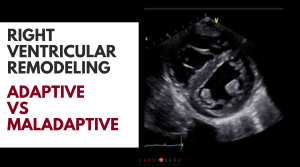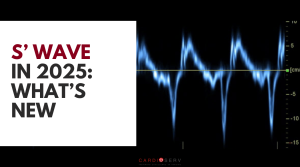
Blog
Home → Blog
While we often think of the pericardium as a protective sac, it’s so much more than that. Under normal conditions, it moves and stretches with every heartbeat, quietly accommodating changes in volume and pressure.
But when it loses that flexibility, the pericardium can transmit pressure back to the heart or even restrict its ability to fill.
And that’s where the pericardial spectrum begins. A continuum that ranges from simple effusion to hemodynamic tamponade and, in chronic or recurrent inflammation, to constriction. Understanding this progression changes the way we view the pericardium and how we interpret our echo findings.
The concept of RV–PA coupling and uncoupling can sound intimidating, but it’s really about how well the right ventricle (RV) and the pulmonary arteries “work together”.
Coupling is the measure of teamwork between the right ventricle and the pulmonary circulation—how efficiently the RV converts its contraction into blood flow through the lungs.
In this article, we’ll explain how to differentiate adaptive vs maladaptive right-ventricular remodeling in pulmonary hypertension using echocardiography, highlighting key imaging features, physiologic differences, and what each pattern means clinically.
In this article, we’ll focus specifically on the RV basal diameter measurement, explore the new severity grading, and discuss the prognostic value of this updated approach to evaluating RV size.
Few measurements in echo are as quick and powerful as the S′ velocity. With a single tissue Doppler tracing of the tricuspid annulus, we can quickly gauge whether the right ventricle is pulling its weight.
In echocardiography, Fractional Area Change (FAC) is one of the most reliable 2D measures of right ventricular (RV) systolic function, offering a comprehensive view of right ventricular performance.
Blog Sign Up
Categories
Categories
Tags
echocardiography
ASE guidelines
echo
cardiac chamber quantification
accreditation
industry spotlight
IAC Standards
CardioServ staff
Mitral Regurgitation
adult echo
quality improvement
intersocietal accreditation commission
cme
case study
Mitral Valve
Right Heart
right ventricle
CardioServ
Diastolic Function
Cardiology
aortic stenosis
tricuspid regurgitation
sonographer
MR
IVC
spotlight
ultrasound
agitated saline
vascular
Mitral Leaflets
echo accreditation
left ventricle
pulmonary hypertension
hemodynamics
interpretive quality
technical quality
report completeness
Educator Spotlight
MUAM
QI maintenance
ICAEL
LVH
inspiring excellence
Mitral Apparatus
right atrial pressure
Recent Post


The Easy Way to Understand RV–PA Coupling and Uncoupling
November 17, 2025


RV Basal Diameter 2025: Updated ASE Grading Explained
November 4, 2025

S′ Wave in 2025: New Grading, Measurement Tips, and Pitfalls
October 27, 2025
